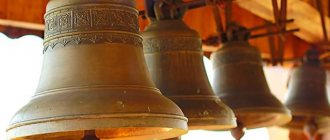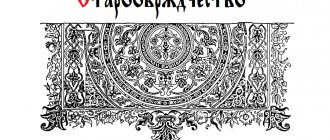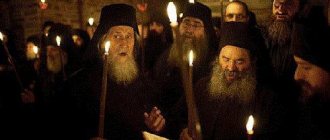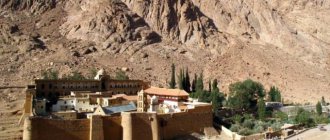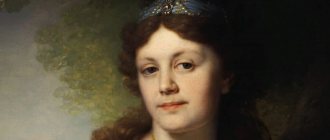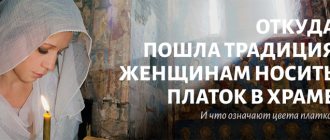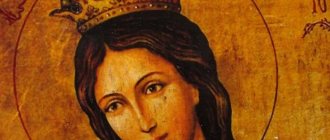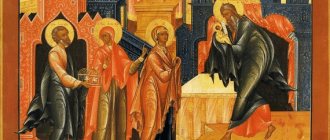Reform
On February 26, 1764, Empress Catherine II issued a decree on church property, which drew a line under the centuries-long confrontation between the Russian Orthodox Church and the Russian state on the issue of church property.
The most important provisions of this legislative act were:
- All estates of the Holy Synod, diocesan sees, monasteries and parishes were finally transferred to the state College of Economy. All church institutions were removed from the management of these estates. The peasants who lived on these estates, whose number according to the revision of 1760 was 910,866 revision souls (that is, only men), were transferred to the jurisdiction of the College of Economy, and in the future they were called economic peasants.
- Instead of corvee work and various quitrents, from January 1, 1764, these peasants were required to pay 1.5 rubles. per capita salary, which went to the state treasury through the College of Economy.
- For the maintenance of church institutions - diocesan sees, monasteries and parish churches that previously owned land, the College of Economy had to allocate a certain amount.
- Dioceses were divided into three classes, and contents were assigned to them depending on the class.
- For monasteries, initially only Great Russian ones, that is, except for those that were subordinate to the Kyiv Metropolitan, monastic states were drawn up, which included 225 (Trinity-Sergius Lavra and Alexander Nevsky Monastery; 156 monasteries; 67 women’s monasteries) divided by monasteries for 3 grades according to content level.
According to the report of the Synod of January 1, 1762, in all the dioceses of Russia there were 954 monasteries, with and without estates, with 11,153 monastics. After secularization in 1764, the Synod decided to abolish 418 monasteries. Of the remaining 226, they received support from the state, while the remaining 310 monasteries, henceforth known as supernumerary, were to exist on the voluntary donations of the people.
On March 31, 1764, an additional order was issued that non-staff monasteries should also be divided into 3 classes: 1st class - 20 monasteries, 2nd class - 56 and 3rd class - 85, a total of 161 monasteries (all male) with 1247 monks. The remaining 149 monasteries were abolished. The remaining provincial monasteries had to exist either on the voluntary donations of the people, or at the expense of the uninhabited land located near the monasteries, which the monks cultivated on their own. Thus, there were 387 monasteries left in Great Russia.
The secularization reform was subsequently extended beyond Great Russia. In 1786, a similar situation was established in Little Russia, i.e. Kyiv, Chernigov and Novgorod-Seversk provinces, and in 1788 - in Slobozhanshchina, i.e. in Kharkov, Ekaterinoslav, Kursk and Voronezh provinces.
Reasons for secularization reform
For the Russian Orthodox Church, the 18th century became the century of the loss of its authority. Russian rulers tried in every possible way to excommunicate the clergy from solving state issues and reduce church land ownership. The secularization of the church became one of the points of this policy. Catherine II in this matter did not differ from her immediate predecessors. Almost immediately after her accession, she cancels the decree of the late Peter III on the confiscation of the lands of dioceses, monasteries and churches. Before ascending the throne, she promised not to encroach on church estates. However, just three weeks after the repeal of Peter’s decree, the ruler created a special commission to resolve the issue of church landownership.
So, there are three main reasons :
- The need to increase tax revenues to the treasury
- Improving land use efficiency
- The desire to eliminate the ability of the church to exist autonomously from the state
Great Russian monasteries for 1764
Regular first-class
- Trinity-Sergius Lavra (men's)
- St. Petersburg Alexander Nevsky Monastery (male)
- Novgorod Yuryev Monastery (male)
- Alexander Dormition Monastery (women's)
- Valdai Iversky Monastery (male)
- Moscow Ascension Monastery (women)
- Moscow Novodevichy Convent (women's)
- Sviyazhsky Assumption Monastery (male)
- Suzdal Intercession Monastery (women)
Regular second-class
- Voronezh Alekseevo-Akatov Monastery (male)
- Vyatsky Trifonov Assumption Monastery (male)
- Kazan Bogoroditsky Monastery (women)
- Novgorod St. Anthony's Monastery of the Nativity (male)
- Pereslavl-Zalessky Danilov Trinity Monastery (male)
- Pskov-Pechersky Monastery (male)
Regular third grade
- Belgorod St. Nicholas Monastery (male)
- Irkutsk Ascension Monastery (male)
- Moscow Chrysostom Monastery (male)
- Nikolo-Ugreshsky Monastery (male)
- Putivl Molchensky Monastery (male)
- Selenga Trinity Monastery (male)
- Tambov Ascension Monastery (women)
- Khotkovsky Intercession Monastery (women)
Supernumerary
- Artemiyevo-Verkolsky Monastery (male)
- Kazan St. John the Baptist Monastery (male)
- Rostov Petrovsky Monastery (male)
- Saratov Transfiguration Monastery (male)
- Sharovkin Assumption Monastery (male)
- Yaroslavl Kirillo-Athanasievsky Monastery (male)
Abolished
- Antoniev-Dymsky Monastery
- Arefinskaya Entrance to Jerusalem Hermitage
- Bezhetsky Vvedensky Monastery
- Bityutsky Trinity Monastery
- Vereisky Entrance to Jerusalem Monastery
- Vozmishchensky Monastery
- Vyaznikovsky Vvedensky Monastery
- Dunilovsky Assumption Monastery
- Eletsky Znamensky Monastery
- Zaretsky Spassky Monastery
- Kozelsky Ascension Monastery
- Kola-Pechengsky Monastery
- Kokhminsky Kazan Monastery
- Krestogorskaya Tikhonova hermitage
- Krutetsky St. Nicholas Monastery
- Likhvinsky Afanasyevsky Monastery
- Likhotnin Assumption Monastery
- Mammoth Desert
- Marovskaya Holy Cross Hermitage
- Meshchovsky Afanasyevsky Peter and Paul Monastery
- Mosalsky Assumption Monastery
- Moscow Varsonofevsky Monastery
- Murom nunnery
- Nikandrova Resurrection Hermitage
- Nuromsky Transfiguration Monastery
- Obnorsky Resurrection Monastery
- Peshnoshsky Nikolsky Monastery
- Perynsky monastery
- Pokrovsky Monastery on the Nerl
- Posolotinsky Monastery
- Rdeisky Monastery
- Solomenskaya hermitage
- Syrinskaya Assumption Hermitage
- Uglich Resurrection Monastery
- Ulyanovsk Spasskaya Hermitage
- Ust-Vymsky Michael-Arkhangelsk Monastery
- Ust-Sarapulsky Spassky Monastery
- Khristoforova Bogoroditskaya hermitage
- Cherepovets Resurrection Monastery
- Chernoezersky Monastery
- Shuisky Trinity Monastery
- Yashezersky Monastery
Consequences of the reform
The financial position of the monasteries began to be determined by the division into states and classes, which led to the emergence of different types of both monasteries and the monks themselves. The funding for full-time monasteries was too little, but the abbots did not dare to report this to the Synod in order to avoid the abolition of the monastery. Due to financial problems, the number of monks had to be reduced, and the monasteries began to collapse and become deserted.
Are you an expert in this subject area? We invite you to become the author of the Directory Working Conditions
Consequences
The secularization reform of 1764 in many ways marked the beginning of a new era in the history of the Russian Orthodox Church.
For the later history of Russian monasticism, the states determined not only the financial situation, but in many ways the spiritual development of the monasteries. Two different types of not only monasteries, but also monks appeared, and the monastic charter as the basis of monastic life lost its significance for a long time. The maintenance determined by the states for the monasteries was too little, it was barely enough for the brethren, the monastery buildings deteriorated and were destroyed from year to year, and the abbots were afraid to report this to the Synod in view of the possibility of the abolition of the monastery. To improve the financial situation of the monasteries, abbots often sought to reduce the number of monastics stipulated by the states. The monasteries became impoverished and depopulated, but in the new conditions, without the burden of worries about property, an incentive appeared for the reconstruction of monastic life on ascetic principles.
Reasons for secularization
Definition 1
Secularization is the seizure of church property by the state.
In Russia, secularization was a sensitive issue throughout the entire 18th century. However, Catherine II, who acted with an eye to the west, still carried it through. In the European policy of Enlightened absolutism, secularization was a mandatory element and was carried out harshly.
Note 1
In addition to the desire to keep up with the times to carry out secularization in the Russian Empire, there were more objective reasons, namely the desire to fill the treasury, because the church owned too much land exempt from tax.
Finished works on a similar topic
- Course work Secularization of church lands 410 rub.
- Abstract Secularization of church lands 250 rub.
- Test paper Secularization of church lands 200 rub.
Receive completed work or specialist advice on your educational project Find out the cost
Well, besides, various excesses, which more than once became the cause of social outbursts, did not correspond to the religious principle of non-covetousness.
Elizaveta Petrovna began preparing this painful reform for many in $1757. After her death, Peter III ordered the process of developing the reform to be accelerated and issued a decree on the transfer of real estate church property to the department of the Senate and on the cessation of subsidies to monasteries that were unable to provide for themselves.
Cultural history
The last important aspect of domestic politics that needs to be addressed concerns the church during the period of palace coups.
In the history of the church of the decades under review, two outwardly dissimilar, but organically interconnected processes took place, culminating in the transformation of the church into an uncomplaining servant of the state. One of them affected the material conditions of life of the clergy, which made them dependent on secular power. This was how the secularization of the domains of the black and white clergy was carried out, although not completely. Another process took place in the spiritual sphere and was accompanied by fruitless attempts by part of the clergy to restore the order that existed before the church reform of Peter I, aimed at reviving the patriarchate.
Peter carried out the partial secularization of church estates back in 1701, but two decades later he returned the estates to the full disposal of the clergy. However, the secularization process acquired such obvious features of irreversibility that already under Catherine I it was decided to reform the Synod, dividing it into two departments, with 6 persons in each. The first, consisting of spiritual hierarchs, was supposed to be in charge of purely church affairs. The second, staffed by secular officials, was entrusted with managing the fiefdoms of the black and white clergy. This measure was motivated by the desire to alleviate the concerns of the clergy, who were entrusted with the care of only spiritual matters. Later, the second department received the name “College of Economy” and in 1738 was transferred from the synod to the department of the Senate. There was one step left before secularization was completed, and Anna Ioannovna was ready to take it. However, as often happens in history, chance intervened. The initiator of the reform, Platon Ivanovich Musin-Pushkin, turned out to be involved in the Volynsky case, which was discussed, and fell out of favor. And the empress herself, who imposed a resolution on him to “perform according to this idea,” died six months later. After the death of Anna Ioannovna, the Synod managed to achieve the liquidation of the College of Economics and after it the creation of the Office of the Synodal Economic Board, which was completely subordinate to it.
It would seem that the fate of the church estates during the reign of the pious Elizabeth Petrovna should have been completely safe, but even she could not resist the imperious spirit of the times, and in 1757 she transferred the management of the estates from the hands of the monastery servants to the hands of the headquarters and chief officers, who were ordered draw up an inventory of the monastery property, as well as a detailed list of peasant duties. However, secularization was not carried out. The Synod and the monastery authorities sabotaged the activities of the officers in every possible way, and Elizaveta Petrovna herself did not show persistence, saying, according to rumors, that “as they want after my death, but I will not sign.” And yet the activities of the officers had an impact on the secularization of the lands. The clergy became convinced that the taking of their lands was inevitable, and therefore began to rapaciously exploit the peasants. The peasants responded by disobeying the monastery administration and refusing to fulfill their duties.
The stubborn resistance of the peasants of many monasteries further accelerated the secularization of church lands. The decree on the complete secularization of church lands was signed by Peter III on March 21, 1762. He did this with extraordinary ease. Firstly, because secularization has been ripening for a long time and the fruit, as they say, only has to fall. Secondly, Peter was not overcome, like Elizaveta Petrovna, by doubts and he was not burdened with either deep faith or a feeling of respect for the Orthodox clergy, but even vice versa. This decree, however, was not implemented. Three months after its promulgation, Ekaterina Alekseevna overthrew her husband from the throne.
The tense relations between secular and spiritual authorities during this period were accompanied by discord among the clergy themselves, most of whom were hostile to the church reform of Peter the Great and his associate who put it into practice, Feofan Prokopovich. If during Peter’s life none of the church hierarchs dared to openly attack Theophanes, then after the death of the emperor he no longer felt safe. A wave of denunciations followed one after another, and Prokopovich had to defend himself sophisticatedly against this wave.
Thus, the first to concoct a denunciation was the Pskov hieromonk Savvaty, acting on the orders of the Novgorod bishop Theodosius, the second vice-president of the Synod. Feofan Prokopovich, accused of stealing jewelry from icons, managed not only to justify himself, but also to bring forward counter-accusations against the intemperate Theodosius, giving them a political overtone. As a result, Theodosius ended up in exile and lost his Novgorod bishopric, and Theophanes acquired it. This technique was successful, and Feofan subsequently struck blows at his opponents, elevating their actions to the rank of political crimes, while collaborating with the secret office. So, in 1726, a new denunciation followed, accusing Theophan of an unfriendly attitude towards Empress Catherine and hostility towards Orthodoxy in general. Prokopovich managed to justify himself this time, and the informer was put behind bars for an incorrect denunciation.
However, the most difficult times for Theophan came after the death of Catherine I, when the youth emperor Peter II came under the influence of the Dolgorukys, who hated the first vice-president. If Peter II had not died so unexpectedly and suddenly, then Theophan would not have escaped the fall and imprisonment in some remote monastery. But he resisted. And after the accession of Anna Ioannovna, he strengthened his position so much that he became the absolute master of the Synod. He easily managed to expel from him such opponents as Georgy Dashkov, who claimed the patriarchal position, Ignatius Smola, Lopatinsky and others. Anna Ioannovna favored Prokopovich for the service he provided during the turbulent February-March events of 1730. He was also patronized by Biron and Osterman.
As a result, Prokopovich began to pursue the same policy of persecuting opponents in the spiritual department as Biron and Osterman carried out in the secular department. So, they inflicted cruel reprisals on the defeated Golitsyn and Dolgoruky, who did not pose any danger to them. Feofan Prokopovich was also guided by the same feeling of revenge, who vigilantly monitored the living conditions of his opponents in monastic confinement, demanding tougher conditions, although they did not pose a threat either to him or to the church reform as a whole. Thus, Prokopovich went down in history in two guises. The first, as a comrade-in-arms of Peter, is a highly educated person, a theorist and practitioner of transformations. And on the other hand, as a cruel and vindictive person who acted contrary to Christian morality and a sense of mercy.
Next - Church and Synod
To the beginning of the section The era of palace coups
Secularization of church lands in history: a brief background
“Secularization is the legalized robbery of churches under the guise of the struggle for justice” (from an unwritten explanatory dictionary)
At all times, secular authorities have been tempted to solve their own problems at the expense of others. Since the Church did not have an army, it is not surprising that the gaze of secular rulers most often fell on church lands. The chances of getting hit on the head with a candelabra when taking away land from churchmen were less than with similar actions against some count or duke.
The first secularization was carried out by the majordomo of the Franks, Charles Martel, in the 1st half of the 8th century. The time was dangerous: the Dark Middle Ages reigned everywhere: in the north and east - wild pagans, in the south - Saracens. It's time to get a good cavalry army. Where can the poor Franks get money for it?
Secularization, Karl!
The legendary majordomo carries out the secularization of church lands. The confiscated lands were distributed to the nobility, who in return had to serve in campaigns with their people. Since then, the franc has become the coolest in the eurozone. After the Vikings, of course.
- In Orthodox Byzantium, Orthodox emperors carried out the secularization of the Orthodox Church land more than once or twice. But with Orthodox love and humility. For example, in 1058, Emperor Isaac I confiscated part of the monastic lands, and the Patriarch of Constantinople Michael Kirularius was removed and mercifully exiled to places not so remote. But they could even slash your throat with a razor!
- In the 15th century, the gloomy genius Martin Luther was born in that same Germany. At some point, Monk Martin realized that the church had become bad and was mired in money and land, and he realized that he needed to tell everyone about it. The German princes listened to him and also guessed that if the property and lands were taken away from the church, then they, too, could get bogged down. In the name of the German people and the Ordnung, of course. And therefore, after the Peasants' War of 1524-26, they carried out secularization.
- English reformers were not inferior to German reformers in ingenuity, and during the Reformation in England in 1536-39, secularized church lands passed to the bourgeoisie and gentry, facilitating the initial accumulation of capital. Since then England has become capitalist...
- With the spread of Protestantism (Zwinglianism and Calvinism) in the Swiss cantons, secularization also spread. The Swiss are almost the same as the Germans.
- The Spanish king Philip cruelly oppressed freedom-loving Holland. He especially oppressed them with a decree of 1559, according to which only theologians with a university education could become bishops in the Netherlands. The Dutch could not tolerate such humiliation and arranged a revolution and secularization for Philip.
- In the 17th century The British realized that not all the property of the churchmen had been secularized, and under the guise of the English Revolution, they finally secularized everything with the Ordinance of 1646 on the destruction of archbishoprics and bishoprics.
- In the 2nd half of the 18th century, enlightened absolutism strengthened throughout Europe. In order for totalitarian-dictatorial absolutism to strengthen faster and stronger, enlightened people used an already proven method: secularization carried out in Austria by Joseph II, and in Portugal by S. J. Pombal.
- After the French Revolution, revolutionary disorder reigned in the country of the Franks. To get out of the terrible financial crisis, by decree of November 2, 1789, it was announced that all church property was transferred to the disposal of the nation - “Peace to the World”, “Land to the People”. A little over a hundred years later, Russian revolutionaries will pull off the same trick.
- Peace in Europe, alas, did not come, but Napoleon appeared. With Napoleon in Europe it was no longer boring at all. Everyone fought, and wars require funds. The solution was obvious - secularization! During the Napoleonic conquests, secularization occurred throughout Western Europe, including Italy.
- Not only the war demanded church lands, but also peace. The Peace of Lunéville in 1801 made it possible to secularize the ecclesiastical principalities in Germany.
- What can we say about Europe, if secularization was carried out in the very center of Catholicism - in Italy. During the unification of Italy, secularization was carried out in 1855, 1866 and 1870. Measure three times, cut once.
- European ideas have always been fashionable in Russia. First Ivan 3, then Ivan 4 tried to take away the lands from the clergy. no way. What the Ivans couldn’t do, the woman could do. In 1764, Empress Catherine carried out enlightened secularization - the bulk of the monastery lands passed to the state. Monasteries and churches were left with small plots of land and their maintenance was guaranteed. Although in this country the opinion has taken root that “everything was taken away, so the churchmen have no right to anything.” But that's a completely different story...
Demyan Bogaty
3, total, today
There are no similar articles...
